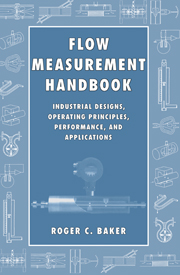Book contents
- Front Matter
- Contents
- Preface
- Acknowledgments
- Nomenclature
- Chapter 1 Introduction
- Chapter 2 Fluid Mechanics Essentials
- Chapter 3 Specification, Selection, and Audit
- Chapter 4 Calibration
- Chapter 5 Orifice Plate Meters
- Chapter 6 Venturi Meter and Standard Nozzles
- Chapter 7 Critical Flow Venturi Nozzle
- Chapter 8 Other Momentum-Sensing Meters
- Chapter 9 Positive Displacement Flowmeters
- Chapter 10 Turbine and Related Flowmeters
- Chapter 11 Vortex-Shedding, Swirl, and Fluidic Flowmeters
- Chapter 12 Electromagnetic Flowmeters
- Chapter 13 Ultrasonic Flowmeters
- Chapter 14 Mass Flow Measurement Using Multiple Sensors for Single- and Multiphase Flows
- Chapter 15 Thermal Flowmeters
- Chapter 16 Angular Momentum Devices
- Chapter 17 Coriolis Flowmeters
- Chapter 18 Probes for Local Velocity Measurement in Liquids and Gases
- Chapter 19 Modern Control Systems
- Chapter 20 Some Reflections on Flowmeter Manufacture, Production, and Markets
- Chapter 21 Future Developments
- Bibliography
- A Selection of International Standards
- Conferences
- References
- Index
Chapter 19 - Modern Control Systems
Published online by Cambridge University Press: 22 September 2009
- Front Matter
- Contents
- Preface
- Acknowledgments
- Nomenclature
- Chapter 1 Introduction
- Chapter 2 Fluid Mechanics Essentials
- Chapter 3 Specification, Selection, and Audit
- Chapter 4 Calibration
- Chapter 5 Orifice Plate Meters
- Chapter 6 Venturi Meter and Standard Nozzles
- Chapter 7 Critical Flow Venturi Nozzle
- Chapter 8 Other Momentum-Sensing Meters
- Chapter 9 Positive Displacement Flowmeters
- Chapter 10 Turbine and Related Flowmeters
- Chapter 11 Vortex-Shedding, Swirl, and Fluidic Flowmeters
- Chapter 12 Electromagnetic Flowmeters
- Chapter 13 Ultrasonic Flowmeters
- Chapter 14 Mass Flow Measurement Using Multiple Sensors for Single- and Multiphase Flows
- Chapter 15 Thermal Flowmeters
- Chapter 16 Angular Momentum Devices
- Chapter 17 Coriolis Flowmeters
- Chapter 18 Probes for Local Velocity Measurement in Liquids and Gases
- Chapter 19 Modern Control Systems
- Chapter 20 Some Reflections on Flowmeter Manufacture, Production, and Markets
- Chapter 21 Future Developments
- Bibliography
- A Selection of International Standards
- Conferences
- References
- Index
Summary
INTRODUCTION
This chapter does not attempt more than a cursory review of modern control systems, as it is outside my main area of expertise. Those knowledgeable in electronics and control will pass quickly over this chapter! Others who wish to delve more deeply may, for instance, turn to Sanderson (1988), Brignell and White (1994), or other experts, or for a good, recent introduction to the control of machinery Foster (1998) is recommended. I am pleased to acknowledge valuable insights obtained from Cranfield lectures given by Bill Black, David Clitherow, Doug de Sa, and others.
This book is about flowmeters that depend, in the main, on mechanical or thermo/fluid mechanical effects. In only one case of mainstream meters, the electromagnetic meter is the signal electrical throughout. The aim of the book has been to bring together information on the performance of these meters based on physical, experimental, and industrial experience. I have made the assumption that the electrical signal interpretation, which is based in the meter, is capable of doing the job set by the designer of interpreting the meter output into a standard electrical form. This assumption is not always adequate (e.g., where electrical signals from the same instrument do not appear to agree with each other). Nevertheless, the developments in design of electrical systems are assumed to be such that the reader will not benefit from a detailed description or that the circuit will be changing so fast that any statement will be out of date.
Information
- Type
- Chapter
- Information
- Flow Measurement HandbookIndustrial Designs, Operating Principles, Performance, and Applications, pp. 438 - 450Publisher: Cambridge University PressPrint publication year: 2000
Accessibility standard: Unknown
Why this information is here
This section outlines the accessibility features of this content - including support for screen readers, full keyboard navigation and high-contrast display options. This may not be relevant for you.Accessibility Information
- 4
- Cited by
